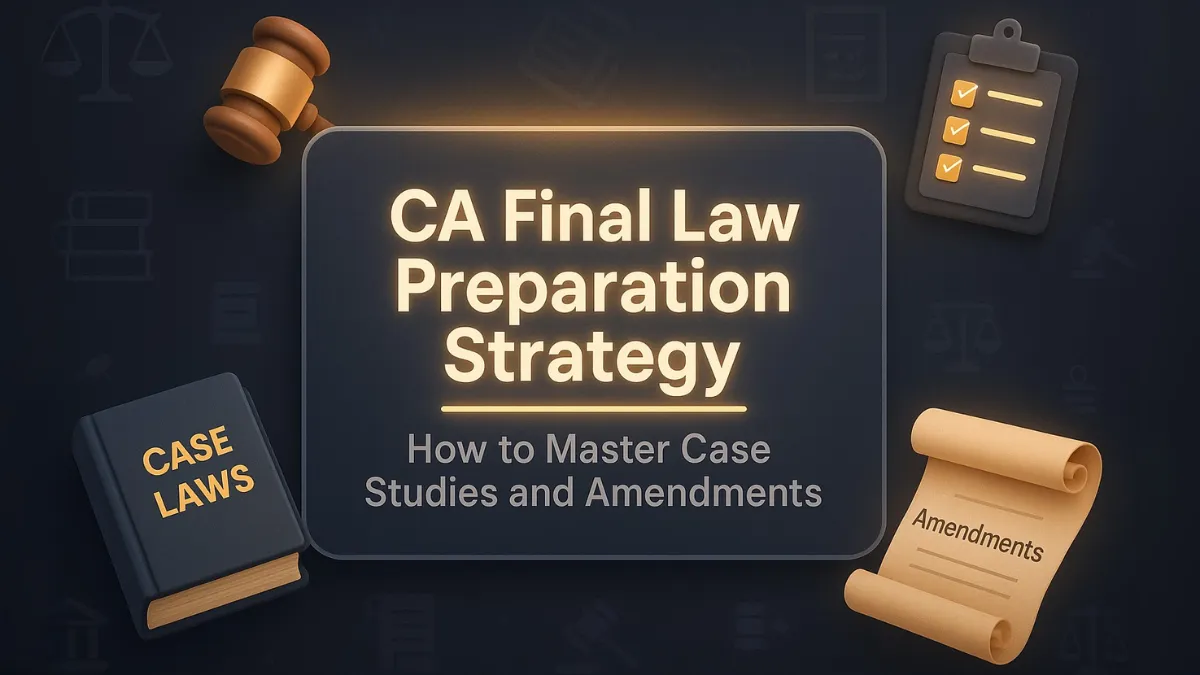Preparing for CA Final Law can feel tough. Many CA Final students worry about case studies and amendments. But if you follow the right plan, it becomes simple. Here’s a guide to help you step by step.
CA Final Law is an important paper. It tests your knowledge of Corporate and Economic Laws. But it’s not just about remembering laws. You need to apply laws to real situations. That is why case studies are important. Also, amendments in laws happen every year. You must know the latest changes because ICAI includes them in the exam.
This guide will show you how to:
- Understand the CA Final syllabus
- Read amendments
- Solve case studies
- Use simple tricks like flowcharts and tables
- Manage your time well during CA Final preparation.
By the end, you will feel more confident and less stressed about CA Final Law.
Understanding the CA Final Law Syllabus
Before starting, you must know the syllabus. Without it, you can waste a lot of time.
CA Final Law mainly has two parts:
- Corporate Laws – Companies Act, 2013, SEBI rules, LLP Act.
- Economic Laws – Finance Act, FEMA, Competition Act, GST laws.
Also, you will face CA Final case studies in exams. These are real-life problems. You have to apply the law to them.
Many CA Final students get confused about the weightage of topics. Here is a simple table:
| Topic | Weightage in Exam |
| Companies Act | High |
| Economic Laws | Medium |
| Amendments | High |
| Case Studies | High |
Tip: Start with high-weightage topics first.
How to Read and Interpret Amendments
Laws keep changing. ICAI gives the latest amendments before exams. You must know them because CA Final exam questions come from changes.
How to study amendments:
- Use ICAI material only – Don’t rely on random notes.
- Understand the reason – Don’t just memorize, understand why the change happened.
- Add to your notes – Write amendments with the old law, so you can compare.
- Revise often – Weekly revision helps you remember.
Example: If Companies Act definition of “related party” changes, write it in a small table comparing old vs new for CA Final Law.
Mastering Case Studies in CA Final Law
Case studies can scare many students. But they are easy if you follow steps:
- Step 1 – Read carefully – Don’t rush. Read the facts 2-3 times.
- Step 2 – Find relevant laws – Identify the sections that apply.
- Step 3 – Analyze the problem – Ask yourself: What is the legal issue here?
- Step 4 – Give solution – Answer clearly. Start with the law, then apply to facts.
Practice daily. Even 1 case per day makes a big difference.
Effective Study Strategies for CA Final Law Preparation
CA Final Law needs smart study, not just hard study.
Tips:
- Daily study – 2-3 hours is enough if focused on CA Final Law topics.
- Topic-wise plan – Divide the CA Final syllabus into small parts.
- Make your own notes – Short, simple, easy to revise.
- Practice questions – Solve past papers, RTPs.
Solving Past ICAI Papers and RTPs
Past papers are your best friend.
Benefits:
- You know question types in CA Final exams
- You learn time management for CA Final paper
- You find weak areas to improve for CA Final Law
Tip: Solve papers like real CA Final exams. Time yourself and check answers honestly. Don’t skip tough questions – they teach you a lot.
Time Management Tips During Exam Preparation
Time is the most important.
Tips:
- Make a timetable and stick to it.
- Start with tough/high-weightage topics.
- Take short breaks – don’t study non-stop.
- Use mock tests to check speed.
- Revise amendments often.
Even 30 minutes per day on CA Final amendments makes a big difference.
Do’s and Don’ts for CA Final Law
Studying CA Final Law can feel like a lot. Some days you feel lost in all the rules and case studies. But don’t worry, a huge difference can be made by a few simple habits. Let’s look at what you should do and what to avoid so CA Final Law doesn’t feel scary.
Do’s
- Understand the law, don’t just memorize – Don’t try to remember lines like a parrot. Ask yourself, “What does this rule mean? How will I use it in a real company?” When you understand it, CA Final case studies become easy.
- Try one case study every day – Even if it’s just a small example, solving it daily makes your brain familiar with applying the rules. Soon, you’ll start seeing patterns.
- Keep up with the latest amendments – Laws change, and ICAI loves asking about them. Check updates from ICAI and jot down the differences in a small notebook. Revising little by little keeps you ready.
- Use charts and drawings – Flowcharts, tables, or small diagrams help you remember steps, like how a company gets registered. It’s faster than reading pages again and again.
- Practice old papers and RTPs – Doing past CA Final exams helps you know what kind of questions appear and how to manage your time. You also see which areas are repeated every year.
- Plan your day – Even a simple schedule, like one hour for theory, one for amendments, and one for CA Final case studies, helps you cover everything without stress.
Don’ts
- Don’t skip amendments – Some students think they’re small changes. But ICAI often asks about these, and missing them can cost marks in CA Final.
- Don’t just memorize – Writing rules without knowing how to use them won’t help. In exams, you need to show you can apply the law, not just repeat it.
- Don’t leave everything for last minute – Law takes time. Trying to learn it all in a week before exams only makes you panic.
- Don’t avoid tricky sections – Parts like FEMA or SEBI rules seem tough. But ignoring them means losing marks. Break them into small bits and practice gradually.
- Don’t lose track of time in the exam – Some students spend too long on one case study and leave others incomplete. Try mock exams to see how to balance your time.
If you follow these simple habits, Law won’t feel like a mountain anymore. Even scary case studies start making sense, and amendments become easier to remember.
Conclusion
CA Final Law is not impossible. It can be mastered with practice and planning by you.
Remember:
- Know the syllabus well
- Study amendments regularly
- Practice case studies daily
- Use flowcharts, tables, diagrams
- Manage your time
If you follow this guide honestly, you will feel confident and ready. Many students pass with high marks by following simple steps. You can too.









